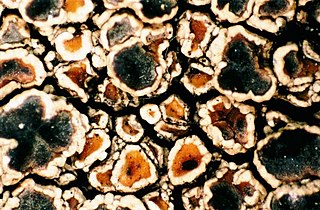
Aspicilia is a genus of mostly crustose areolate lichens that grow on rock. Most members have black apothecia discs that are slightly immersed in the areolas, hence the common name"Given the same reason, the naming of Aspicilia is derived from the Greek word for "shield concave".

Megasporaceae are a family of fungi belonging to the order Pertusariales. Taxa are lichenized with green algae, and grow on rocks, often in maritime climates close to fresh water. Phylogenetic analysis has shown that this family is related to the Pertusariaceae, another family of lichens. The genus Aspicilia was moved here from the Hymeneliaceae.

Vulpicida is a genus of lichenized fungi in the family Parmeliaceae. Circumscribed in 1993 to contain species formerly placed in Cetraria, the genus is widespread in Arctic to northern temperate regions, and contains six species. The genus is characterized by the presence of the secondary metabolites pulvinic acid and vulpinic acid, compounds that when combined with usnic acid, give the species their characteristic yellow and green colors.

Circinaria is a genus of crustose lichens in the family Megasporaceae. It was circumscribed by Johann Heinrich Friedrich Link in 1809.
Acarospora dissecta is a species of saxicolous (rock-dwelling), crustose lichen in the family Acarosporaceae. It grows on volcanic rock in high-altitude regions of the Andes. Its distinguishing features include a crust-like formation of dispersed areoles, a unique combination of organic acids, and a distinctive fissuring pattern. This lichen thrives in the semi-desert, high Andean areas, and currently, its known distribution is limited to specific areas in Bolivia.
Byssoloma fuscothallinum is a species of foliicolous (leaf-dwelling) lichen in the family Pilocarpaceae. Found in Colombia and French Guiana, it was formally described as a new species in 2006 by lichenologist Robert Lücking.
Calopadia saxicola is a species of saxicolous (rock-dwelling) crustose lichen in the family Pilocarpaceae. It is found on the rocky shores of southern Brazil, where it thrives in the shade of vegetated zones and grows directly on rocks away from other crustose lichens. The lichen was formally described as a new species in 2015. Calopadia saxicola stands out from its close relatives due to its well-defined thallus, reddish-brown disc, thicker hymenium, and smaller conidia.
Coenogonium kalbii is a species of corticolous (bark-dwelling), crustose lichen in the family Coenogoniaceae. It has been found in variety of locations in the southern region of Costa Rica, primarily in humid, shaded microsites within low-mountain rainforest environments.
Circinaria mansourii is a species of terricolous (ground-dwelling) crustose lichen in the family Megasporaceae. It is primarily found on soil or plant debris in Iran, particularly in the mountainous steppe-like habitats. It was described as new to science in 2011.
Protothelenella is a genus of fungi in the family Protothelenellaceae. It contains 11 species, some of which form lichens. Protothelenella species have a crustose thallus with spherical to pear-shaped, dark brown to blackish perithecia. Microscopic characteristics of the genus include bitunicate asci with an amyloid tholus, and ascospores that are colourless and contain multiple internal partitions. Some species grow on acidic substrates including rocks, soil, bryophytes, plant detritus or rotten wood. Other species are lichenicolous (lichen-dwelling), growing on species of Solorina, Peltigera, Pseudocyphellaria, or Cladonia.
Calogaya orientalis is a species of corticolous (bark-dwelling) and muscicolous lichen (moss-dwelling), crustose lichen in the family Teloschistaceae. It is found in arid steppe and desert habitats in Northwestern China, Iran, and Turkey. The thallus of this lichen is reduced, similar to species in the genus Athallia.
Schaereria porpidioides is a species of saxicolous (rock-dwelling), crustose lichen in the family Schaereriaceae. It is found in the Falkland Islands.
Upretia is a genus of lichen-forming fungi in the family Teloschistaceae. It has three species of saxicolous (rock-dwelling), crustose lichens. Upretia is characterised by its small ascospores and narrow, rod-shaped conidia. The distribution of the genus ranges from mid-altitude rocky terrains in India to both arid and higher altitudinal environments in China.
Sirenophila cliffwetmorei is a species of saxicolous (rock-dwelling), crustose lichen in the family Teloschistaceae. It is found in Australia. Its thallus can reach up to 1 centimetre in width, has a whitish to whitish-grey colour, and is very thin, sometimes almost merging with the substrate, and has paler edges with a darker grey centre. Its numerous tiny apothecia give the thallus a yellow-orange appearance.
Buellia cravenii is a species of saxicolous (rock-dwelling), crustose lichen in the family Caliciaceae. It is found in Australia. The lichen spreads up to 3.5 cm wide thick, forming a continuous, grey-white cracked pattern of areoles.
Pyrenodesmia micromarina is a species of saxicolous (rock-dwelling), crustose lichen in the family Teloschistaceae. It is found in the Eastern Mediterranean, specifically along the coasts of the Black Sea and the Sea of Marmara in Russia, Turkey, and Ukraine. It grows on coastal rocks and occasionally concrete, often in Mediterranean scrub vegetation.
Caloplaca kiewkaensis is a species of bark- and wood-dwelling crustose lichen in the family Teloschistaceae. Described as a new species in 2011, this lichen is found in the Far East region of Russia, specifically within Primorsky Krai.

Flavoplaca oasis is a species of saxicolous (rock-dwelling), crustose lichen in the family Teloschistaceae. It is widely distributed across Europe, and has been reported in Western Asia, China, and North Africa.
Filsoniana ferdinandmuelleri is a species of saxicolous (rock-dwelling), crustose lichen in the family Teloschistaceae. It is found in Australia. The lichen has a squamulose (scaly) thallus, with a range of bright yellow to greenish-yellow and brownish-orange colours in its soredia and apothecia, respectively. The areoles of this lichen are varied in size, slightly raised from the thallus surface, and each carries one to four apothecia. The soralia are rounded or irregularly shaped, covering most of the thallus surface as a yellow to greenish-yellow mass. The apothecia have dark brownish-orange discs, surrounded by slightly paler yellow margins, with the spore-bearing asci containing typically eight brownish-golden ascospores.
Nitidochapsa is a genus of lichen-forming fungi in the family Graphidaceae. It has five species of corticolous (bark-dwelling), crustose lichens.




